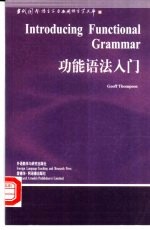图书介绍
功能语法入门PDF|Epub|txt|kindle电子书版本下载

- (英)Geoff Thompson著;黄国文导读 著
- 出版社: 北京:外语教学与研究出版社
- ISBN:7560019870
- 出版时间:2000
- 标注页数:267页
- 文件大小:11MB
- 文件页数:318页
- 主题词:
PDF下载
下载说明
功能语法入门PDF格式电子书版下载
下载的文件为RAR压缩包。需要使用解压软件进行解压得到PDF格式图书。建议使用BT下载工具Free Download Manager进行下载,简称FDM(免费,没有广告,支持多平台)。本站资源全部打包为BT种子。所以需要使用专业的BT下载软件进行下载。如BitComet qBittorrent uTorrent等BT下载工具。迅雷目前由于本站不是热门资源。不推荐使用!后期资源热门了。安装了迅雷也可以迅雷进行下载!
(文件页数 要大于 标注页数,上中下等多册电子书除外)
注意:本站所有压缩包均有解压码: 点击下载压缩包解压工具
图书目录
1.The purposes of linguistic analysis1
1.1 Starting-points1
1.1.1 Goingin through form2
1.1.2 Going in through meaning6
1.2 Language,context and function:a preliminary exploration10
Exercise11
2.Identifying clauses and clause constituents13
2.1 Breaking up the sentence and labelling the parts13
2.1.1 Recognising constituents13
2.1.2 Structural and functional labels17
2.2 Ranks20
Exercise24
3.An overview of Functional Grammar26
3.1 Three kinds of meaning26
3.1.1 The three metafunctions28
3.1.2 Three kinds of function in the clause30
3.1.3 Three kinds of structure in the clause32
3.1.4 Bringing it all together33
3.1.5 A fourth metafunction35
3.2 Register and genre35
4.Interaction in the clause:the interpersonal metafunction38
4.1 Introduction38
4.2 Roles of addressers and audience39
4.3 Mood41
4.3.1 The structure of the Mood41
4.3.2 Identifying Subject and Finite42
4.3.3 Meanings of Subject and Finite44
4.3.4 Mood in non-declarative clauses46
4.3.5 The Residue50
4.3.6 Modal Adjuncts52
4.4.1 Modality and polarity56
4.4 Modality56
4.4.2 Types of modality57
4.4.3 Modal commitment59
4.4.4 Modal responsibility60
4.4.5 Modality in text63
4.5 Evaluation65
4.6 Interaction and negotiation67
4.7 Interaction in text70
Exercises73
5.Representing the world:the experiential metafunction76
5.1 Introduction76
5.2 Transitivity78
5.2.1 Material processes79
5.2.2 Mental processes82
5.2.3 Relational processes86
5.2.4 Other types of process96
5.2.5 Other participant roles102
5.2.6 Circumstances104
5.2.7 Transitivity in text107
5.3 Ergativity112
Exercises115
6.Organising the message:the textual metafunction:Theme117
6.1 Introduction117
6.2 Theme118
6.3 Identifying Theme119
6.3.1 Theme in declarative clauses119
6.3.2 Theme in non-declarative clauses122
6.4 Thematising structures125
6.4.1 Thematic equatives125
6.4.2 Predicated Theme127
6.4.3 Thematised comment129
6.4.5 Passive clauses and Theme130
6.4.4 Preposed Theme130
6.5 Theme in clause complexes131
6.6 Multiple Theme133
6.6.1 Conjunctions in Theme134
6.6.2 Conjunctive and modal Adjuncts in Theme134
6.6.3 Textual,interpersonal and experiential elements in Theme136
6.6.4 Interrogatives as multiple Themes137
6.7 Some problems in Theme analysis138
6.7.1 Existential'there'as Theme138
6.7.2 Theme in reported clauses139
6.7.3 Interpolations in Theme139
6.7.4 Preposed attributives140
6.8 Theme in text141
Exercises144
7.1 Cohesion and coherence147
7.Organising the message:the textual metafunction:cohesion147
7.2 Reference and ellipsis148
7.2.1 Reference148
7.2.2 Ellipsis152
7.3 Conjunction156
7.4 Cohesion in text158
Exercise161
8.Grammatical metaphor163
8.1 Introduction163
8.2 Experiential and logical metaphors166
8.3 Interpersonal metaphors172
8.4 Textual metaphor176
8.5 A cautionary note176
Exercises177
9.1.1 Nominal groups179
9.Groups and phrases179
9.1 Groups179
9.1.2 Verbal groups185
9.1.3 Other types of group188
9.2 Prepositional phrases189
9.3 Group complexes190
Exercises192
10.Clauses in combination194
10.1 Units of analysis194
10.2 Types of relations between clauses196
10.2.1 Logical dependency relations196
10.2.2 Logico-semantic relations200
10.3 Expansion201
10.3.1 Elaborating201
10.3.2 Extending203
10.3.3 Enhancing204
10.4 Projection206
10.4.1 Quotes and reports206
10.4.2 Facts209
10.4.3 Projection in text210
Exercises211
11.Implications and applications of Functional Grammar214
11.1 Three-dimensional analysis of texts214
11.2 A summary review of Functional Grammar220
11.3 Using Functional Grammar222
11.4 Closing224
Answers to exercises225
Further Reading250
References254
Index257
文库索引263